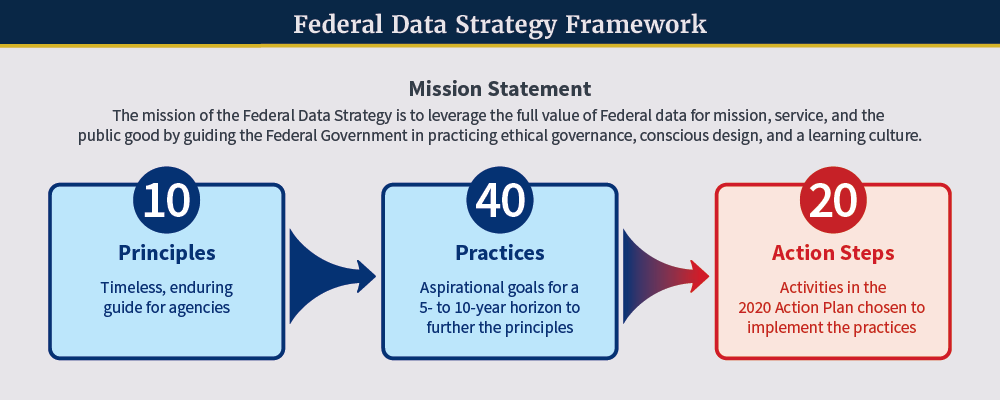Overview
Components of the Federal Data Strategy

The Strategy comprises of four components to guide federal data management and use:
-
Mission Statement: The mission statement articulates the intent and core purpose of the Strategy.
-
Principles: The ten principles serve as timeless guidance to agencies in the areas of: Ethical Governance, Conscious Design, and Learning Culture. These principles informed the development of practices, the 2020 Action Plan, and will also inform subsequent action steps for the Strategy.
-
Practices: The 40 practices guide agencies on how to leverage the value of data, focusing on Building a Culture that Values Data and Promotes Public Use; Governing, Managing, and Protecting Data; and Promoting Efficient and Appropriate Data Use. The practices informed the development of the 2020 Action Plan and will inform the development of subsequent action steps for the Strategy.
-
Annual Action Plan: Specify measurable activities to implement the practices and that are the priority for a given year, providing timeframes for implementation and identification of responsible parties.
Agencies will implement the Federal Data Strategy by adhering to the requirements of the Action Steps in yearly Action Plans in accordance with OMB guidance.
Mission
The mission of the Federal Data Strategy is to fully leverage the value of federal data for mission, service, and the public good by guiding the Federal Government in practicing ethical governance, conscious design, and a learning culture.-
Principles
Ethical Governance
- Uphold Ethics
- Exercise Responsibility
- Promote Transparency
Conscious Design
- Ensure Relevance
- Harness Existing Data
- Anticipate Future Uses
- Demonstrate Responsiveness
Learning Culture
- Invest in Learning
- Develop Data Leaders
- Practice Accountability
-
- Identify Data Needs to Answer Key Agency Questions
- Assess and Balance the Needs of Stakeholders
- Champion Data Use
- Use Data to Guide Decision-Making
- Prepare to Share
- Convey Insights from Data
- Increase Accountability of Federal Spending
- Monitor and Address Public Perceptions
- Connect Data Functions Across Agencies
- Provide Resources Explicitly to Leverage Data Asset
-
Action 1: Identify Data Needs to Answer Priority Agency Questions
Action 4: Identify Opportunities to Increase Staff Data Skills
Action 7: Launch a Federal Chief Data Officer Council
Action 9: Improve Financial Management Data Standards
Action 11: Develop a Repository of Federal Enterprise Data Resources
Action 12: Create an OMB Federal Data Policy Committee
Action 14: Develop a Data Ethics Framework
-
- Prioritize Data Governance
- Govern Data to Protect Confidentiality and Privacy
- Protect Data Integrity
- Convey Data Authenticity
- Assess Maturity
- Inventory Data Assets
- Recognize the Value of Data Assets
- Manage with a Long View
- Maintain Data Documentation
- Leverage Data Standards
- Align Agreements with Data Management Requirements
- Identify Opportunities to Overcome Resource Obstacles
- Allow Amendment
- Enhance Data Preservation
- Coordinate Federal Data Assets
- Share Data Between State, Local, and Tribal Governments and Federal Agencies
-
Action 1: Identify Data Needs to Answer Priority Agency Questions
Action 2: Constitute a Diverse Data Governance Body
Action 3: Assess Data and Related Infrastructure Maturity
Action 4: Identify Opportunities to Increase Staff Data Skills
Action 5: Identify Priority Datasets for Agency Open Data Plans
Action 6: Publish and Update Data Inventories
Action 7: Launch a Federal Chief Data Officer Council
Action 10: Integrate Geospatial Data Practices into the Federal Data Enterprise
Action 11: Develop a Repository of Federal Enterprise Data Resources
Action 12: Create an OMB Federal Data Policy Committee
Action 14: Develop a Data Ethics Framework
Action 15: Develop a Data Protection Toolkit
Action 17: Pilot an Automated Tool for Information Collection Reviews That Supports Data Inventory Creation And Updates
Action 18: Pilot Enhanced Data Management Tool for Federal Agencies
Action 19: Develop Data Quality Measuring and Reporting Guidance
Action 20: Develop a Data Standards Repository
-
- Increase Capacity for Data Management and Analysis
- Align Quality with Intended Use
- Design Data for Use and Re-Use
- Communicate Planned and Potential Uses of Data
- Explicitly Communicate Allowable Use
- Harness Safe Data Linkage
- Promote Wide Access
- Diversify Data Access Methods
- Review Data Releases for Disclosure Risk
- Leverage Partnerships
- Leverage Buying Power
- Leverage Collaborative Computing Platforms
- Support Federal Stakeholders
- Support Non-Federal Stakeholders
-
Action 1: Identify Data Needs to Answer Priority Agency Questions
Action 2: Constitute a Diverse Data Governance Body
Action 4: Identify Opportunities to Increase Staff Data Skills
Action 5: Identify Priority Datasets for Agency Open Data Plans
Action 6: Publish and Update Data Inventories
Action 8: Improve Data and Model Resources for AI Research and Development
Action 10: Integrate Geospatial Data Practices into the Federal Data Enterprise
Action 11: Develop a Repository of Federal Enterprise Data Resources
Action 13: Develop a Curated Data Skills Catalog
Action 14: Develop a Data Ethics Framework
Action 15: Develop a Data Protection Toolkit
Action 16: Pilot a One-stop Standard Research Application
Action 19: Develop Data Quality Measuring and Reporting Guidance
